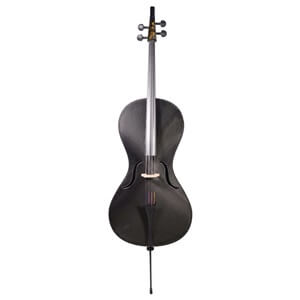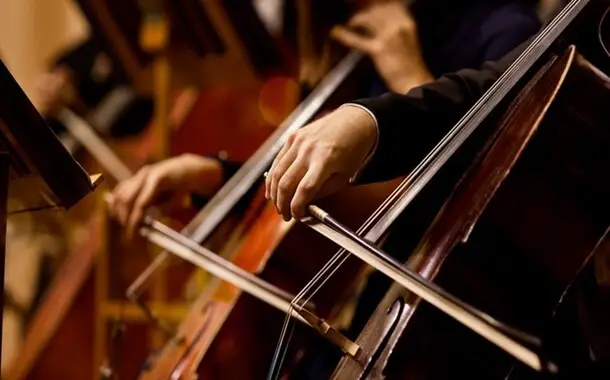How Much Does a Cello Cost?
Last Updated on December 16, 2023
Written by CPA Alec Pow | Content Reviewed by ![]() CFA Alexander Popinker
CFA Alexander Popinker
The cello produces a rich, resonant sound that sings with emotion. This versatile string instrument also carries a reputation for high prices that intimidates beginners. If you’re curious whether a cello is within your budget, read on. We’ll decode cost ranges, price structures, influencing factors, additional expenses, money-saving strategies, and final recommendations.
We’ll provide transparent pricing details for student, intermediate, advanced, and professional tier cellos. You’ll discover real-world numbers on both new and used instruments plus extras like cases and bows. Whether looking to channel your inner Yo-Yo Ma or simply introduce music into your life, get an answer to the question: How much does a cello cost? This will help you strike the right chord between quality and affordability.
How Much Does a Cello Cost?
The cost of a cello is anywhere between $500-$2,500 for a student cello, $3,000-$7,000 for an intermediate one, $7,000-$10,000+ for a more advanced cello, $15,000-$20,000+ for a professional instrument, or more than $50,000 for a master or collectible cello.
Within each tier, costs vary based on new/used status, age, materials, workmanship, sound quality, visual appeal, brand recognition, and other attributes. Most beginner cellists start with budget student models that cost around $1,000 new or $700 used. Intermediate players may invest $3,000-$5,000 in an instrument that unlocks better tone/playability. Professionals usually seek elite cellos that cost around $15,000+, while master instruments fetch astronomical sums.
Cello Price Range on Different Websites
| Store | Cello Model/Type | Price |
|---|---|---|
| Fiddlershop | Tower Strings Entertainer Cello Outfit | $999.00 |
| Fiddlerman Apprentice Cello Outfit | $1,329.00 | |
| Fiddlerman Concert Cello Outfit | $1,579.00 | |
| Fiddlerman Artist Cello Outfit | $1,779.00 | |
| Fiddlerman Master Cello Outfit | $2,469.00 | |
| Fiddlerman Soloist Cello Outfit | $3,419.00 | |
| Holstein Bench Guarneri Cello | $7,900.00 | |
| Ming Jiang Zhu 903 Cello | $4,499.00 | |
| Ming Jiang Zhu 905 Cello | $5,499.00 | |
| Ming Jiang Zhu 907 Cello | $6,799.00 | |
| Ming Jiang Zhu 909 Cello | $7,999.00 | |
| Glasser Carbon Composite Cello Outfit | From $4,320.00 | |
| Glasser Carbon Composite 5-String Cello Outfit | $6,750.00 | |
| Glasser Carbon Composite Acoustic-Electric Cello | From $8,775.00 | |
| Mezzo-Forte Carbon Fiber Evo Line Cello | $3,200.00 | |
| StringWorks | Crescendo Cello | $1,495 |
| Artist Cello | $1,695 | |
| Artist Cello for Baroque Lovers | $1,775 | |
| NS NXT4a Electric Cello | $1,939 | |
| Virtuoso Cello | $2,595 | |
| Maestro Cello | $2,895 | |
| Virtuoso Special Edition Cello | $2,895 | |
| Soloist III Cello | $3,295 | |
| Special Edition Maestro Cello | $3,395 | |
| Michael Todd III Cello (Various Editions) | Up to $7,500 | |
| Reverb | Various New and Used Cellos (Yamaha, Palatino, etc.) | $229.98 – $3,799 |
| String Emporium | Émile Gillet cellos | $3,450 |
| Various cellos | $3,110 – $3,455 | |
| Linda West Cellos | Various Models (Vivo, Angel Taylor, etc.) | $2,450.00 – $24,500.00 |
The Structuring of Cello Prices
A cello’s total sticker price is a combination of:
- Base Instrument Cost: Determined primarily by wood quality, craftsmanship, sound production, and aesthetics. This accounts for most of the price.
- Cello Bow Cost: Usually 10-15% of total cello cost. Better bows utilize higher-grade materials.
- Case Cost: Can range from $200-$2000+ depending on protectiveness and aesthetics. Hard cases with hygrometers run $500+.
Taxes, shipping/handling, and optional accessories like rosin and endpin anchors add further costs. Always clarify what’s included in advertised pricing.
Factors Influencing Cello Costs
Crafting a cello involves a blend of skill, tradition, and the right materials, each playing an important role in determining the instrument’s value and appeal.
A big part of what makes a cello special is the skill of the person who makes it. The best luthiers who are really good at blending great sound with beautiful design, often charge more for their work. Their expertise doesn’t just make the cello sound better; it also makes it look like a piece of art.
The type of wood used is really important too. Woods like maple and spruce that have been allowed to age naturally are popular because they make the cello sound better and look nicer. As the wood ages, it changes in ways that improve the sound and look of the cello.
 The way a cello sounds is crucial. The best ones have a rich sound, last longer when you play a note and can make a wide range of sounds and volumes. This is all thanks to the skill of the luthier in shaping and putting together the cello.
The way a cello sounds is crucial. The best ones have a rich sound, last longer when you play a note and can make a wide range of sounds and volumes. This is all thanks to the skill of the luthier in shaping and putting together the cello.
A cello’s history can also make it more valuable. If it was played by famous musicians or made for royalty, it could be worth a lot, mostly because of its backstory.
You might also like our articles about the cost of a violin, a hurdy-gurdy, or a harp.
Brand names can also drive up the price of a cello, just like with cars and watches. Well-known brands are often associated with high quality and craftsmanship, which can make their instruments more expensive.
Custom features like special designs, carvings, and colors also add to the cost. These unique touches make each cello one-of-a-kind and tailored to the musician’s taste.
Modern features like electronic pickups and preamps are also becoming more common. These additions help with amplifying the sound and managing effects, making the cello more versatile for different types of performances.
Luthiers also have to think about what their customers can afford. They need to find the right balance between making a high-quality instrument and keeping it affordable. This balance changes depending on whether the musician is a student or a professional, and it’s important for luthiers to make instruments that fit different budgets and skill levels.
Additional Ownership Costs for This Instrument
While the cello itself accounts for the majority of costs, maintaining and advancing skills requires further investments that impact budgets:
- Tuning/Adjustment – Expect $80-$100+ per annual tune-up by a luthier.
- New Strings – Players change cello strings every 6-12 months at around $80 per set.
- Bridge/Soundpost Work – Such adjustments run $250-$500 if changing string types/tensions.
- Bow Rehairs – Bow rehairs every year or two cost $65-$100.
- Instrument Insurance – Insuring cellos for damage/theft adds $200+ annually.
- Lessons/Classes – In-person and online instruction ranges $25-$100 per lesson.
- Sheet Music – Building musical repertoires carries costs for books/subscriptions.
- Accessories – Metronomes, rosin, rockstops, humidifiers, and other gear is ongoing.
Saving Money on Cellos
If quoted cello prices are outside of your financial possibility, there are still some creative solutions to consider:
- Rent-To-Own – Monthly rental payments apply towards eventual instrument purchase over 1-2 years typically.
- Payment Plans – Most shops break pricing into installments of $100-$500 monthly with low/no interest.
- Buy Used – Save 40-60% buying older cellos; costs offset by maintenance needs.
- Student Discounts – Music schools and youth programs often loan quality cellos at reduced student rates.
- Bartering – Some luthiers accept trade work (social media services, carpentry, etc) as payment.
- Grants – Arts organizations and music nonprofits sometimes provide need-based cello grants.
- Crowdfunding – Musicians have successfully crowdfunded cello purchases from fans/communities.
With some creativity, cello playing lies within nearly every budget’s reach. Partner with providers focused on structuring deals rather than maximizing profits.



Leave a Reply
Want to join the discussion?Feel free to contribute!